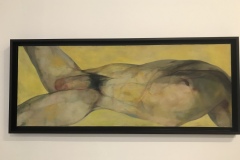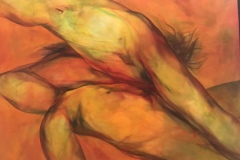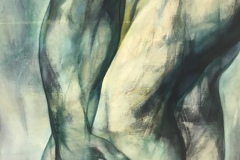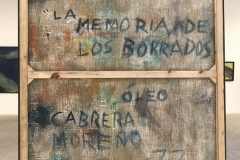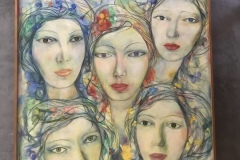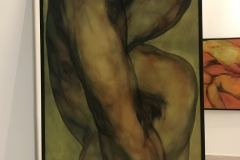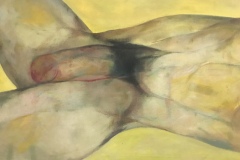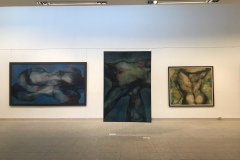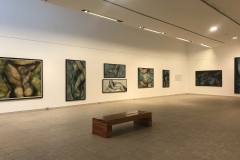Remembering Cuban Artist Servando Cabrera

By Irina Pino
HAVANA TIMES – We met them on a bus, at the entrance of a theater. Or maybe it was on a rainy afternoon, at the Museum of Fine Arts, while we were looking at paintings by Servando Cabrera. There were the voluptuous bodies, braided in the free will of a homosexual and passionate love. They were scenes as seen from different angles. Provocative images with their beauty and implicit violence. An explosion of color and shapes. Fragments of bodies in pure ectasy. If there is an exact term to define these seconds of glory.
A story I wrote begins this way. Such was the impact Servando’s homoerotic work had (and still has) on me.
This Cuban contemporary artist, who claimed to be influenced by Picasso, was born 100 years ago. The National Museum of Fine Arts wants to “revere him” with the exhibition: “Servando Cabrera, remembering the erased.” Doing so with a collection of his work that includes styles such as Cubism, Abstractionism and Expressionism. The book and documentary La hora azul was also released.
Honestly though, none of this will redeem him from the censorship and ostracism he suffered by Cuban institutions and officials who served in the 1960s and 1970s, the ones who couldn’t get their head around a gay artist painting the Revolution. The punishment was ten years without being able to hold an exhibition in his own country.
They tried to suppress his work at this very museum. To erase it from Cuba’s cultural map. Just because of his sexual orientation.
It was the time of the UMAP (forced labor camps), a hellish chapter in our history, that lasted from 1965 until 1968. I can imagine the artist’s fear if he were to be recruited. He could have anticipated his death, committing suicide if it were to happen.
Despite everything, he was brave. The sharper eye can discern an intention to show the secret side of his sexuality in that iconography of revolutionary heroes, workers, machete-wielding men, with their square, manly features; there’s the painting of the three men with three guano hats, where one of them has his arm over the shoulders of the man next to him, and the third one looks at them out of the corner of his eye. Are they not real machos? It’s not what it seems, as they are united by a strange melting pot.
It’s no coincidence there aren’t any women among these men. Yes, he loved men, and he captured them in every one of his paintings.
Then, he slowly began to paint the delicate, almost feminine, faces of young men, and women with phallic necks. It was a new idea. What did he want to show to the world? Was he doing it on purpose? He was clearly going through some inner rebellion. Maybe he wanted to shout out: Yes, I’m gay and I like penises!
Like every talented artist, he wanted to move to other disciplines, and he studied costume and stage design. Movies also captured his attention, and he took part in the documentary El Megano, that would then serve for him to recreate the lives of coal sellers. He even appeared on the movie poster.
I’ve always loved his way of creating. I saw his first painting when I was working at Casa de las Americas as a watch person. It was the only job I managed to get in a Ministry of Labor office. They only paid 100 pesos a month. But, I learned a few things about art. I also took out interesting books from the library. Those were a busy two years.
I saw that oil painting just after the Storm of the century. It was magnificent, large, with rhomboid figures standing out, embedded in yellow splendor. I don’t need to tell you that I fell in love with that painting, which if I recall correctly was from his Cubist era. At that time, I found out that they had it stored in the storage room at the Galeria Latinoamericana. It wasn’t on exhibit.
It was Friday March 1993, when the storm that devastated Havana came. Heavy rains and harsh winds. There was a kind of sea surge, and the waters of the Malecon spilled over and flooded all of 3rd Street.
Of course, there was significant damage to the gallery. There was earth and stones all over the building, a lot of crafts were destroyed. The painting was also damaged. I remember that the director of Visual Arts said that it needed urgent restoration work, it was an invaluable piece. Days after things were cleaned up, a group of restorers came.
I also cherish beautiful memories of Villa Lita, the mansion on Paseo between 17th and 19th Streets in Vedado, where there are paintings, furniture and objects that belonged to the painter. I love his collection of popular art, especially the glass objects, that include different shaped bottles. It also has a library where you can study and research his life and work.
I used to take my son to a painting workshop in this very building, every Saturday. The teacher was a kind and very patient person, as her students were 7 or 8 years old.
That’s where my son got his sensitivity from, experimenting with drawing and painting.
Recently, whenever I walk around this part of the city, I look at the house sadly, because it’s been undergoing restoration work for years. Ironically, it never ends. Nobody knows or wants to say anything about the subject. It’s shameful to see the garden neglected, the plants dry because they haven’t been watered, and the abandoned sculptures covered in dust.
This means the public can’t visit it. As a result, people who want to come and learn about Servando Cabrera need to go to the Internet, to people who knew him, to research and essays about his work. Or look for biographies by his artist friends, that reveal successes where rabid critics ventured to destroy his work, the abuse and harassment he suffered. Likewise, all of the apologies he’s owed. It’s true: Servando wasn’t a prophet in his land, in Cuba.
It’s not worth making peace, the truth needs to be told, and at the top of our lungs.
Read more from the diary of Irina Pino here on Havana Times.

